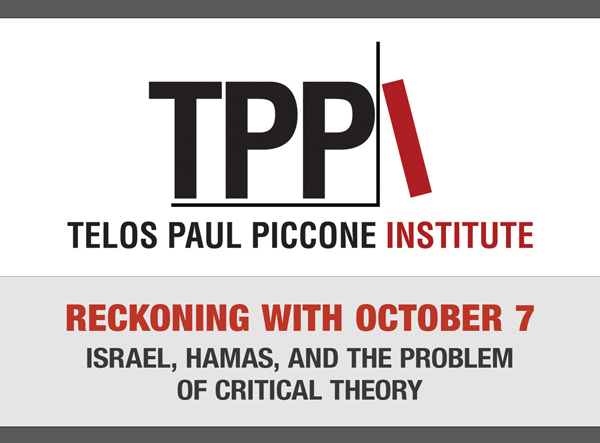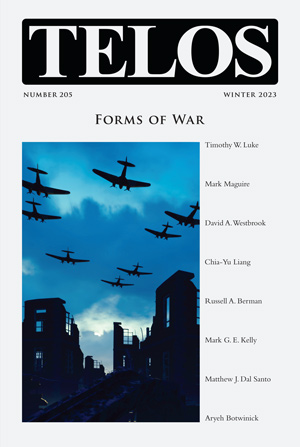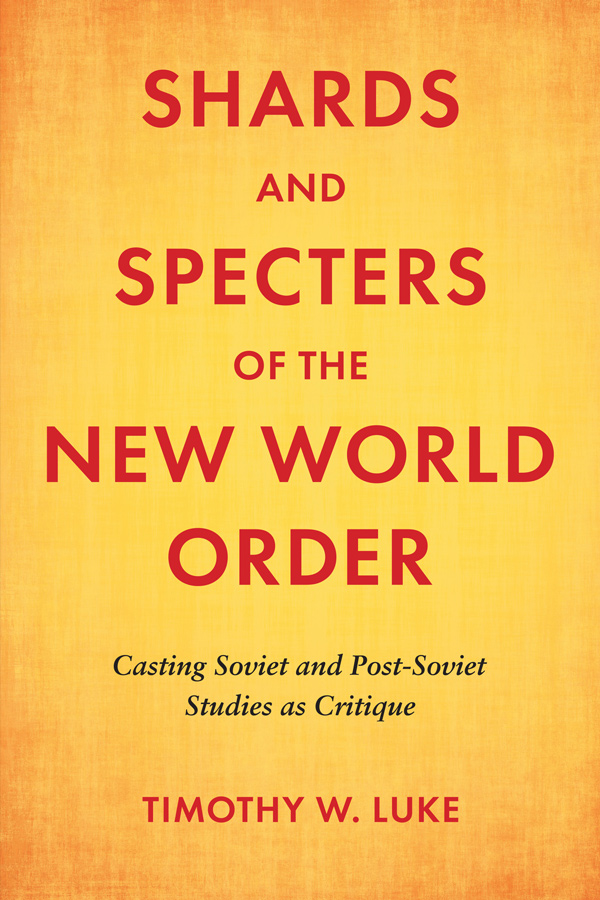 The second webinar in the Telos-Paul Piccone Institute’s yearlong series reckoning with the response to October 7 will take place on Wednesday, February 7, 2024, at noon Eastern Standard Time. The title of the panel will be “Historians on Ideology and Politics in the 1948 War: October 7 and the Aftershocks of World War II.” The second webinar in the Telos-Paul Piccone Institute’s yearlong series reckoning with the response to October 7 will take place on Wednesday, February 7, 2024, at noon Eastern Standard Time. The title of the panel will be “Historians on Ideology and Politics in the 1948 War: October 7 and the Aftershocks of World War II.”
Click here to register for the event.
Continue reading →
By David Pan · Friday, January 12, 2024 Telos 205 (Winter 2023): Forms of War is now available for purchase in our store. Individual subscriptions to Telos are also available in both print and online formats.
 One of the most challenging aspects of the wars in Ukraine and Israel is the way in which the conflicts have been constantly shifting in form. In the first place, there is a conventional ground war between Russia and Ukraine, in which the identity and will of the two peoples are at stake. Yet Russia has used weapons supplied by Iran and North Korea, and Ukraine relies on NATO for its own supplies, indicating that this war depends on the maintenance and expansion of alliances. The stability of these alliances in turn depends on a combination of Realpolitik and shared values as the glue that holds them together. This logic of alliances motivates the energy war that Russia is waging with Europe, revealing that, unbeknownst to Europe, Russian energy policy over the last decade was an early form of the war. Similarly, the threat of nuclear war also tests the resolve of NATO, forcing it to consider the values at stake in the conflict. Is the war about Ukraine’s sovereignty or the principle of nation-state sovereignty itself? Is it about human rights for Ukrainians or the entire human rights project? For Russia, is it about self-defense or a pan-Slavic identity? Is it about the protection of Russian minorities in Ukraine or the threat of Western secularization? The answers to these questions will determine the will to fight on each side and thus the length and ferocity of the war. One of the most challenging aspects of the wars in Ukraine and Israel is the way in which the conflicts have been constantly shifting in form. In the first place, there is a conventional ground war between Russia and Ukraine, in which the identity and will of the two peoples are at stake. Yet Russia has used weapons supplied by Iran and North Korea, and Ukraine relies on NATO for its own supplies, indicating that this war depends on the maintenance and expansion of alliances. The stability of these alliances in turn depends on a combination of Realpolitik and shared values as the glue that holds them together. This logic of alliances motivates the energy war that Russia is waging with Europe, revealing that, unbeknownst to Europe, Russian energy policy over the last decade was an early form of the war. Similarly, the threat of nuclear war also tests the resolve of NATO, forcing it to consider the values at stake in the conflict. Is the war about Ukraine’s sovereignty or the principle of nation-state sovereignty itself? Is it about human rights for Ukrainians or the entire human rights project? For Russia, is it about self-defense or a pan-Slavic identity? Is it about the protection of Russian minorities in Ukraine or the threat of Western secularization? The answers to these questions will determine the will to fight on each side and thus the length and ferocity of the war.
Similarly, the war between Israel and Hamas began with Hamas’s use of terror and rape as instruments of war. The idea was to provoke Israel into attacking Hamas and causing civilian casualties. Because the terrain of war extends to public opinion in the West, Hamas’s use of Israeli hostages and Palestinian human shields becomes part of its strategy of increasing civilian casualties in the war. Even though Hamas is the ultimate cause of such casualties, Hamas is able to pressure Israel by placing civilians in the path of Israel’s war effort. The conflict on the ground in Gaza is thus overshadowed by the struggle for hearts and minds across the globe.
Continue reading →
By The Telos-Paul Piccone Institute · Wednesday, January 10, 2024  The first webinar in our yearlong series reckoning with the response to October 7 is available here. Panelists included Cary Nelson, Abe Silberstein, and Manuela Consonni. Their conversation was moderated by Israel initiative director Gabriel Noah Brahm. Eighty audience members heard their illuminating conversation, which provided a model of respectful engagement amidst disagreement, and many stayed for another hour for a casual, after-panel discussion. The first webinar in our yearlong series reckoning with the response to October 7 is available here. Panelists included Cary Nelson, Abe Silberstein, and Manuela Consonni. Their conversation was moderated by Israel initiative director Gabriel Noah Brahm. Eighty audience members heard their illuminating conversation, which provided a model of respectful engagement amidst disagreement, and many stayed for another hour for a casual, after-panel discussion.
The next webinar in the Israel webinar series will take place on Wednesday, February 7, at noon ET.
Continue reading →
By Telos Press · Friday, December 22, 2023 Now available: Shards and Specters of the New World Order, by Timothy W. Luke. Order the paperback edition today in our online store and save 20% by using the coupon code BOOKS20. Also available in Kindle ebook format at Amazon.com.
Shards and Specters of the New World Order: Casting Soviet and Post-Soviet Studies as Critique
by Timothy W. Luke
 From ideological dynamics in revolutionary Russia, cultural stagnation in the USSR, and ineffective Soviet governance in the 1980s to the USSR’s institutional collapse in 1991, the emergence of the Russian Federation under Boris Yeltsin, and Vladimir Putin’s wars in Ukraine since 2014, Timothy W. Luke’s Shards and Specters of the New World Order investigates how the geopolitical clout of the United States has worked to contain, but at other times sustain, the Soviet Union and later the Russian Federation. Luke’s critical studies also examine how Moscow’s strategies provoked radical Islamic resistance movements in Afghanistan and aided anti-Western client states, like Iraq and Syria, that threatened the New World Order envisioned in Washington after 1991. From ideological dynamics in revolutionary Russia, cultural stagnation in the USSR, and ineffective Soviet governance in the 1980s to the USSR’s institutional collapse in 1991, the emergence of the Russian Federation under Boris Yeltsin, and Vladimir Putin’s wars in Ukraine since 2014, Timothy W. Luke’s Shards and Specters of the New World Order investigates how the geopolitical clout of the United States has worked to contain, but at other times sustain, the Soviet Union and later the Russian Federation. Luke’s critical studies also examine how Moscow’s strategies provoked radical Islamic resistance movements in Afghanistan and aided anti-Western client states, like Iraq and Syria, that threatened the New World Order envisioned in Washington after 1991.
Continue reading →
By Russell A. Berman · Monday, December 18, 2023  In this brief interview, Martin Cüppers refers to Islamic antisemitism in Germany as a “reimport.” That terse designation builds on his core thesis that during the 1930s Nazi Germany exported its particular brand of antisemitism, with all its uncompromising viciousness, to the Arab world, where it spread and festered and eventually came to define the Arab–Israeli conflict. With the considerable immigration from the Arab world into Germany, especially after 2015, this same Nazi legacy has returned to Europe. The Federal Republic of Germany, which made serious efforts to develop a memory culture and to face up to the German culpability for the Shoah, had in effect opened its doors to carriers of some of the same Nazi values that it had done its best to overcome. The refugees from the Arab world were Germany’s own “return of the repressed.” In this brief interview, Martin Cüppers refers to Islamic antisemitism in Germany as a “reimport.” That terse designation builds on his core thesis that during the 1930s Nazi Germany exported its particular brand of antisemitism, with all its uncompromising viciousness, to the Arab world, where it spread and festered and eventually came to define the Arab–Israeli conflict. With the considerable immigration from the Arab world into Germany, especially after 2015, this same Nazi legacy has returned to Europe. The Federal Republic of Germany, which made serious efforts to develop a memory culture and to face up to the German culpability for the Shoah, had in effect opened its doors to carriers of some of the same Nazi values that it had done its best to overcome. The refugees from the Arab world were Germany’s own “return of the repressed.”
Cüppers’s argument about Nazi ideology as a source for Palestinian and more broadly Arab antisemitism is part of a larger body of scholarship that includes the publications by Jeffrey Herf, Matthias Küntzel, and Elham Manea in particular. Thanks to this research, the claim has become incontrovertible that Nazi Germany played a significant role in shaping the ideology of the Arab–Israeli conflict in ways that continue today and that explain the unique brutality of the October 7 Hamas attacks as well as the aspiration for a massive elimination of Jews from the region. It is exactly that which finds expression in the frequent call for Arab Palestine––فلسطين عربية—which means Arabs only, and no one else (one looks in vain in the founding documents of the PLO or Hamas for any commitment to minority rights).
Continue reading →
By Bernhard Junginger · Monday, December 18, 2023  Editor’s note: Martin Cüppers directs the Research Unit Ludwigsburg at the University of Stuttgart in Germany, where he also teaches in the Department of History. He studies the crimes of the Nazi regime, especially the Holocaust, and how they were treated by postwar German society and its judiciary. Together with Klaus-Michael Mallmann he published Halbmond und Hakenkreuz: Das Dritte Reich, die Araber und Palästina [Half Moon and Swastika: The Third Reich, the Arabs and Palestine] in 2006. His work belongs to a growing body of scholarship that exposes how Nazi Germany was able to insinuate its exterminationist antisemitism into the Middle East and how that influence continues to poison Arab and especially Palestinian views of Israelis and Jews in general. Other contributions to this important line of research include books by Matthias Küntzel, such as Jihad and Jew-Hatred (Telos Press, 2009) and Nazis, Islamic Antisemitism and the Middle East (Routledge, 2024), Jeffrey Herf’s Nazi Propaganda for the Arab World (Yale Univ. Press, 2009), and Elham Manea’s The Perils of Nonviolent Islamism. The Nazi genealogy of Palestinian animosity toward the Jews helps understand the particular viciousness of the Hamas attack of October 7, 2023. This interview originally appeared in the Augsburger Allgemeine Zeitung on December 5 and appears here with Cüppers’s permission. Translated by Russell A. Berman, whose commentary appears here. Editor’s note: Martin Cüppers directs the Research Unit Ludwigsburg at the University of Stuttgart in Germany, where he also teaches in the Department of History. He studies the crimes of the Nazi regime, especially the Holocaust, and how they were treated by postwar German society and its judiciary. Together with Klaus-Michael Mallmann he published Halbmond und Hakenkreuz: Das Dritte Reich, die Araber und Palästina [Half Moon and Swastika: The Third Reich, the Arabs and Palestine] in 2006. His work belongs to a growing body of scholarship that exposes how Nazi Germany was able to insinuate its exterminationist antisemitism into the Middle East and how that influence continues to poison Arab and especially Palestinian views of Israelis and Jews in general. Other contributions to this important line of research include books by Matthias Küntzel, such as Jihad and Jew-Hatred (Telos Press, 2009) and Nazis, Islamic Antisemitism and the Middle East (Routledge, 2024), Jeffrey Herf’s Nazi Propaganda for the Arab World (Yale Univ. Press, 2009), and Elham Manea’s The Perils of Nonviolent Islamism. The Nazi genealogy of Palestinian animosity toward the Jews helps understand the particular viciousness of the Hamas attack of October 7, 2023. This interview originally appeared in the Augsburger Allgemeine Zeitung on December 5 and appears here with Cüppers’s permission. Translated by Russell A. Berman, whose commentary appears here.
Mr. Cüppers, in your book Half Moon and Swastika you explore the connections between the Third Reich, the Arab world, and the Palestine conflict. What is your main finding?
In light of our current context, the book makes clear that the terrible Hamas massacre of October 7 was inconceivable without the historical influences of Nazi Germany.
Continue reading →
|
|
 The second webinar in the Telos-Paul Piccone Institute’s yearlong series reckoning with the response to October 7 will take place on Wednesday, February 7, 2024, at noon Eastern Standard Time. The title of the panel will be “Historians on Ideology and Politics in the 1948 War: October 7 and the Aftershocks of World War II.”
The second webinar in the Telos-Paul Piccone Institute’s yearlong series reckoning with the response to October 7 will take place on Wednesday, February 7, 2024, at noon Eastern Standard Time. The title of the panel will be “Historians on Ideology and Politics in the 1948 War: October 7 and the Aftershocks of World War II.” 








